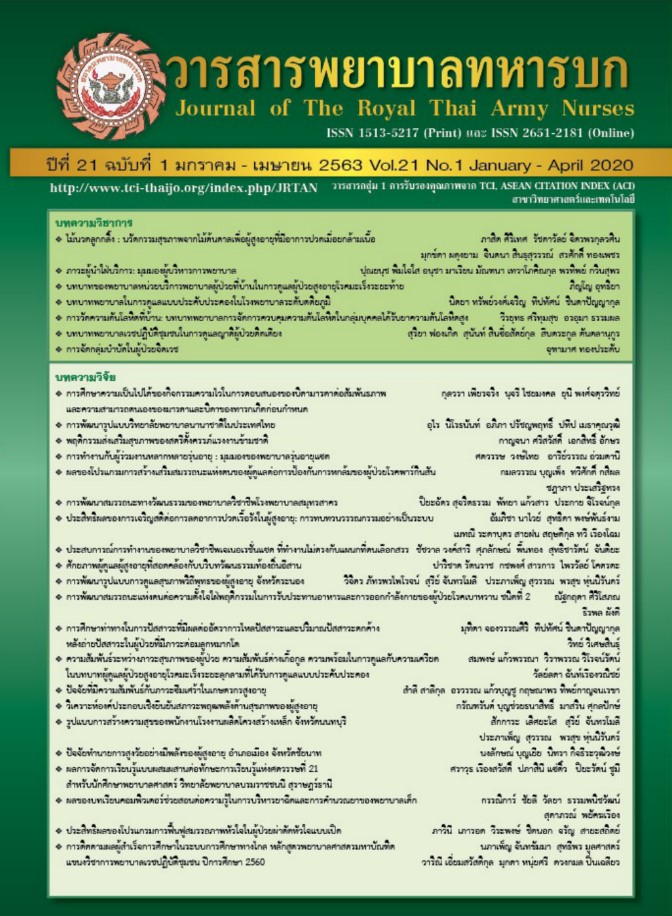Relationship between Ecological Understanding and Physical Activity Patterns of Adults Living with HIV Throughout The Lifespan
Keywords:
adults living with HIV, Ecological understanding, physical activityAbstract
This descriptive research aimed to study the relationship between ecological model and pattern of physical activities, of adults living with HIV, through the lifespan. The questionnaire was used for 101 purposive sample. The findings of the study revealed the people living with HIV (PLHIV) as the following:
1) Able to take medicines at the very good and excellence levels (74.20%).
2) The waist-hip ratio of both sexes was in normal (54.50%) whereas the mean of 6-minute walk was 376.5 meters.
3) Able to cope with stigma in terms of ashamed at the highest mean, and family members less treat differently.
4) The findings of the relationships of variables were as follows;
4.1 Pain was significate related to the physical activity.
4.2 Self-efficacy showed positive relationship with physical activity.
4.3 Pain showed negative relationships with both exercise and physical activity.
4.4 Environment behavioral setting significantly associated with exercise.
4.5 The policy characteristics in term of, park and recreation center showed positive relationship with exercise.
4.6 Depression and pain had negative relationship with physical activity. Stratified by comorbidity, depression significantly relation with physical activity only in patients without hypertension. The significant relationship between pain intensity and physical activity in currently diagnosed with hypertensio
Downloads
References
2. Bureau of Epidemiology, Department of Disease Control Ministry of Public Health. Summary of the situation of AIDS and HIV infection in Thailand. Nonthaburi: Bureau of Epidemiology, Department of Disease Control Ministry of Public Health. 2015. (in Thai)
3. Santasngan S. Pansuwan N and Namwong T. HIV infection situation in Thailand 2017. Nonthaburi: Bureau of Epidemiology, Department of Disease Control Ministry of Public Health. 2018. (in Thai)
4. Schouten J and Group AS. Comoribidty and aging with HIV: A prospective comparative cohort study. In XIX International AIDS Conference July 26th 2012. Washington DC. UNAIDS. Global AIDS Update. Geneva: unaids.org. 2012.
5. Triant VA, Lee H, Hadigan C and Grinspoon SK. Increased acute myocardial infarction rates and cardiovascular risk factors among patients with human immunodeficiency virus disease. J Clin Endocrinol Metab. 2017; 92(7): 2506- 2512.
6. Friis-Moller N, Sabin CA, Weber R; et.al. Combination antiretroviral therapy and the risk of myocardial infarction. The New England journal of medicine. 2003; 349: 1993-2003.
7. Yahiaoui A, McGough EL and Voss JG. Development of evidence-based exercise recommendations for older HIV-infected patients. J Assoc Nurses AIDS Care. 2012; 23(3): 204-219.
8. Do AN, Rosenberg ES, Sullivan PS; et al. Excess burden of depression among HIV-infected persons receiving medical care in the united states: Data from the medical monitoring project and the behavioral risk factor surveillance system. PLoS One. 2014; 9: e92842.
9. Foster C, Hillsdon M, and Thorogood M; et.al. Interventions for promoting physical activity. Cochrane Database of Systematic Reviews. 2005; 25: CD003180.
10. Alemi F and Neuhauser D. A thinking person’s step by step guide to changing your life style weight loss & exercise program. London: Trafford Publishing. 2005.
11. Chaiphibalsarisdi P, Sajeanpong P and Soontarnurak T. Health literacy of people living with HIV and professional team: Case study in Pathum Thani province of Thailand. Journal of Nursing Science Chulalongkorn University. 2015; 27 (2): 22-33. (in Thai)
12. World Health Organization. Waist circumference and waist-hip ration: Report of a WHO expert consultation. Geneva: WHO. 2008.
13. Department of Disease Control ministry of Public Health. National AIDS prevention and solution Strategy 2014-2016. Bangkok: Printing Agriculture Cooperative of Thailand Printing. 2012. (in Thai)
14. Campo M, Ourser KK and Huang L; et al. Association of chronic cough and pulmonary function with 6-minute walk test performance in HIV infection. J Acquir Immune Defic Syndr. 2014; 65(5): 557-563.
15. George S, Bergin C and Clarke S; et.al. Healthrelated quality of life and associated factors in people with HIV: an Irish cohort study. Health and Quality of the Outcomes. 2016; 14: 115.
16. Arruda Junior ER, Lacerda HR and Moura LC; et.al. Risk factors related to hypertension among patients in a cohort living with HIV/AIDS. Brazilian Society of Infectious Diseases. 2010; 14(3): 281-287.
17. Gray L, Falzon C and Bergamaschi A; et.al. Exercise stereotypes and health-related outcomes in French people living with HIV: development and validation of an HIV exercise stereotypes scale (HIVESS). Health and Quality of the Outcomes. 2016; 14: 157.
18. Bopp CM, Phillips KD and Fulk LJ; et.al. Physical activity and immunity in HIV-infected individuals. AIDS Care. 2004; 16(3): 387-393.
19. Frantza JM and Murenzib A. The physical activity levels among people living with human immunodeficiency virus/acquired immunodeficiency syndrome receiving high active antiretroviral therapy in Rwanda. SAHARA J. 2013; 10(3-4): 113-118.
Downloads
Published
How to Cite
Issue
Section
License
บทความหรือข้อคิดเห็นใดใดที่ปรากฏในวารสารพยาบาลทหารบกเป็นวรรณกรรมของผู้เขียน ซึ่งบรรณาธิการหรือสมาคมพยาบาลทหารบก ไม่จำเป็นต้องเห็นด้วย
บทความที่ได้รับการตีพิมพ์เป็นลิขสิทธิ์ของวารสารพยาบาลทหารบก
The ideas and opinions expressed in the Journal of The Royal Thai Army Nurses are those of the authors and not necessarily those
of the editor or Royal Thai Army Nurses Association.






